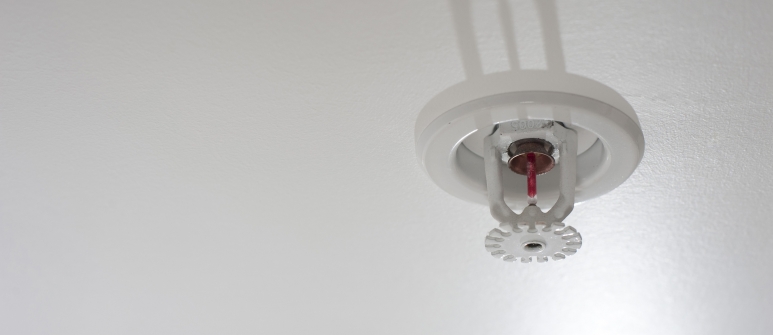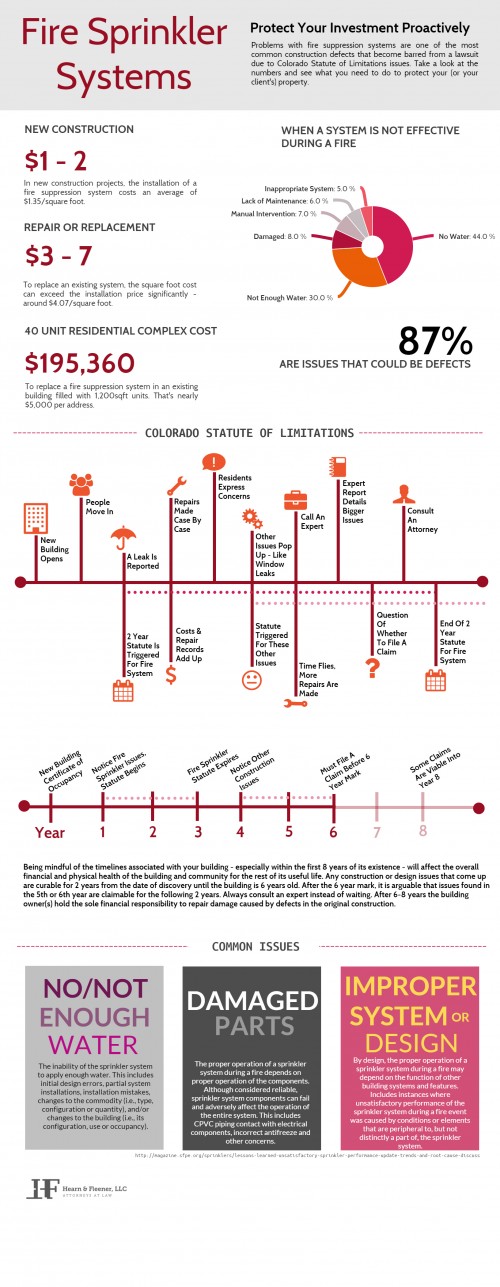
Construction Defect Claims That Often Miss the Boat – Fire Sprinklers (Drip, Drip, Drip)
Posted on March 15, 2016 by Jessica MeekerWritten by: Shane Fleener
Featured in: Colorado Real Estate Journal’s Multifamily Quarterly
When thinking of common construction defects here in Colorado, most people think of defective windows, doors or roofs and the resulting water damage they cause. Others think of problems associated with improper grading and drainage, such as soil movement and resulting structural, drywall, or flatwork damage. Curiously missing from this list are fire suppression system (a/k/a fire sprinkler system) defects.
From multi-family apartment and condo projects to single family homes, the installation of fire suppression systems is now commonplace in Colorado. So why is it that fire sprinklers often miss the construction defect boat? It’s not because all fire sprinkler systems are defect free. Given their complexity and the number of variables involved, improper installation is far too common. According to a 2013 report by the National Fire Protection Association, 87% of ineffective sprinkler responses in fire incidents are caused by improper installation, design and/or system type.
The real reason they often miss the boat is that most property owners and managers mistakenly perceive the early symptoms of fire sprinkler defects as minor annoyances, when they may be symptoms of a system-wide defect. By the time the full extent of the problem is realized, it is often too late to file a claim under Colorado law. This can be a costly mistake. The cost to repair or replace a defective fire sprinkler systems is high, potentially exceeding four times the original installation price depending on the size and type of the system – not to mention time and inconvenience. The goal of this article is to help property owners and managers avoid this pitfall, protect their investments and ensure that those responsible pay for necessary repairs.
In Colorado, the threat of freezing sprinkler pipes often drives the system design. There are two ways to approach this problem: install a “dry” system, which uses pressurized air to hold water behind valves in the pipes and thus away from freezing temperatures or, install a “wet” system which is filled with an antifreeze solution including glycerin and propylene glycol. While both systems have their faults, in the author’s experience, wet systems are more commonly found to have defective attributes.
Wet fire suppression systems – as the name implies – have liquid present in them at all times. The pipes are very often constructed with CPVC (chlorinated polyvinylchloride). If the wrong types or amount of antifreeze chemicals are used, the CPVC may crack and leak. Cracking can also be caused by an accumulation of certain pipe lubricants or when excess pipe cement has pooled in the pipe. External contact of CPVC pipe with electrical wiring or PVC piping can also cause damage to CPVC pipes.
It is very beneficial for property owners and managers understand and be able to recognize the symptoms of fire sprinkler defects. While it is possible for an entire pipe or sections of pipe to rupture, the damage and symptoms are usually far more subtle. Signs of an issue often start with interior cracking or corrosion of the pipes. While not visible, this damage will reveal itself as rust or those annoying leaks or drips of water coming from the pipes, connections and/or sprinkler heads.
In the view of many, such leaks are irksome. They are persistent, come at all hours of the night, cause property damage, and there is often no perceived rhyme or reason as to why (or where) they appear. As a result, they are commonly treated as isolated annoyances that should be punch-listed or repaired on a case-by-case basis at the property owner’s cost. For this reason, fire sprinkler leaks are rarely attributed to a construction or design defect, especially early on in a building’s lifecycle. Therein lies the problem.
With very few exceptions, a construction defect claim in Colorado must be filed within two years after a property owner discovered (or should reasonably have discovered) the physical manifestation of the defect. C.R.S. § 13-80-104 and C.R.S. § 13-80-102. In this case, the “physical manifestation” of fire suppression system defects are often those annoying little leaks or rust, which often appear during the first few years after the system is turned on. In the event of a later defect claim on behalf of the whole building, Colorado law may view those same leaks that were repaired on and off over the past couple years as evidence of sprinkler system defects that the owner knew about. Property owners may not be able to include their fire suppression system in the construction defect claim if more than two years has passed since first noticing those leaks. This may be true even if the property owner did not learn of system-wide defects until years later, which is often the case.
Conclusion
While not always the case, fire sprinkler leaks can be symptoms of a construction or design defect. Unfortunately, even when sprinkler leaks are symptoms of a defect, they are rarely recognized as such at the beginning. These symptoms should not be taken lightly and should be addressed proactively and in a timely fashion. Otherwise, your fire sprinkler problems could miss the construction defect boat. Simply stated, don’t ignore those annoying fire sprinkler leaks or you may end up paying for someone else’s mistake.
References
2015 VFP Fire Systems http://www.vfpfire.com/systems-dry-pipe.php
2011 Willis Insurance http://www.willis.com/documents/publications/Services/Claims_Management/YSK_26_Antifreeze_Sprinklers.pdf

